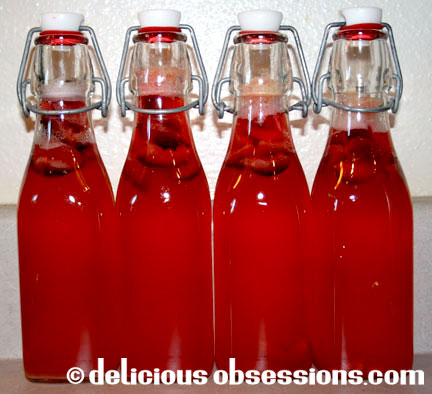FTC Disclosure: Delicious Obsessions may receive comissions from purchases made through links in this article. As an Amazon Associate I earn from qualifying purchases.Read our full terms and conditions here.
About a year ago, I wrote about water kefir, so I’m not going to go into a lot of detail about what it is. For background information on water kefir, why it’s awesome, and a basic how-to and recipe, please check out my post, Water, Water, Everywhere, and Lots of Drops to Drink. I did, however, want to write an updated post about my new experiences with water kefir. And by new, I mean post-Mason jar era.
The Post Mason-Jar Era of Brewing Water Kefir
Awhile back, I invested in a couple of Fido-style jars for my ferments. Because I cannot afford to shell out the money for the Probiotic Jars at this time, this was the next best option. They are the same type of jars, except the Probiotic Jars come with an airlock and hole drilled into the lid (not something I am going to attempt to do, so I will be going airlock-free for now). So far, the ferments that I have made in my Fido jars have been awesome! Waaaaaaaaay better than my mason jar ferments ever were.
Dear Trusty Mason Jar,
I still love you and you hold a very special place in my heart and my kitchen. I will continue to use you daily, just not for my ferments.
Yours Truly,
Jessica
So, when I got the Fido jars, I decided that the first thing I wanted to do was make water kefir in them. According to the research that I discussed in my post, Fermenting Methods: We’ve Had it All Wrong, where I shared the information that KerryAnn from Cooking Traditional Foods had been putting out, one of the things we covered was that kefir, both milk and water, need to be anaerobic ferments. This was a total change from the way I had been taught (mason jar with a coffee filter). I was skeptical, but I usually am of anything that takes me out of my normal routine!
So, I made my normal sugar water mixture (1/4 cup organic cane sugar to 1 quart of filtered water) and placed the cooled liquid in my 1 liter Fido jar with my water kefir grains. I latched the lid and left it to sit on my counter at room temperature for 24 hours. I always make my water kefir in the evenings, so I had meant to burp it the next morning, but forgot. There were some rumors that if you used these Fido-style jars without the airlocks and you did not burp them, they would explode. So far, I have not experienced this and I honestly don’t think it is a commonplace occurrence.
The following evening (24 hours from the start of the kefir), I decided it was ready to be bottled for the second ferment. The first ferment smelled just like you expect water kefir to smell (slightly sweet and yeasty, but pleasant).
And then there was the fizz!
I have never had the first ferment of my water kefir get this fizzy, but this stuff was bubbling so much that when I filled up my flip-top Grolsch-style bottles for a second ferment, the bottles actually overflowed, even though I was a good inch below the mouth of the bottle. I added some fresh lemon juice and some sliced peaches. I capped the bottles and let them sit out at room temperature for another 24 hours. Then I stuck the bottles in the fridge.
The next day, after the bottles had been in the fridge overnight and were nice and cold, I cracked one of them open. It was an immediate geyser of water kefir. I grabbed a glass and salvaged as much as possible. But, let me tell you — I have never, ever had water kefir that was so fizzy and I have been using my flip-top bottles for a long time. To me, that was a good indication that the first ferment yielded very happy water kefir. Plus, the taste of the water kefir was like no other water kefir I’d ever brewed. It was mild, super fizzy, and uber refreshing, especially since Denver has been on a heat wave streak with 100+ degree weather. An ice cold glass of water kefir will satisfy your thirst and give your belly love!
So, that sealed the deal for me. From that point on, I have been brewing my water kefir in my Fido-style canning jars and have never had better tasting, super bubbly water kefir. I cannot recommend the Fido jars enough. They are totally transforming the way I ferment!
Check out this Water Kefir Flavor Guide for lots of ideas on how to flavor your water kefir!
Do you want to start making your own water kefir at home? If so, read my post “How to Make Water Kefir“. If you have questions about water kefir, check out my Water Kefir FAQs. Also, my friend Lydia over at Divine Health From The Inside Out put together a Water Kefir Troubleshooting post, that might be helpful to new brewers and experienced brewers alike!
For more information on water kefir, check out these posts:
52 Weeks of Bad A** Bacteria – Week 23 – Water Kefir Revisited
Water, Water, Everywhere, and Lots of Drops to Drink!
Water Kefir Flavor Guide – Lots of Delicious Fizzy Flavors!
So, tell me. How do you brew your water kefir? Have you tried the Fido jars? If so, what has been your experience? Leave me a comment below!


57 Comments